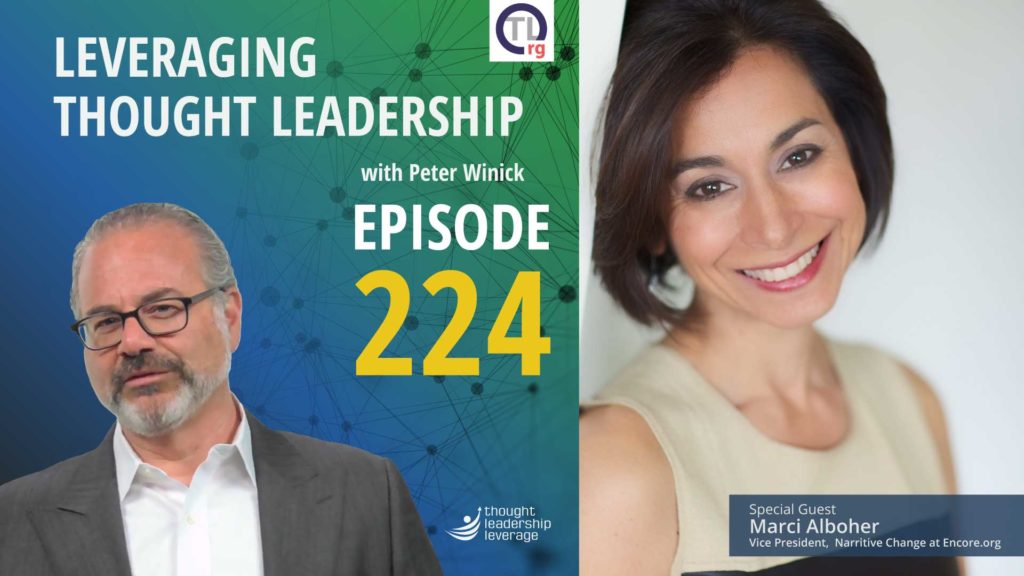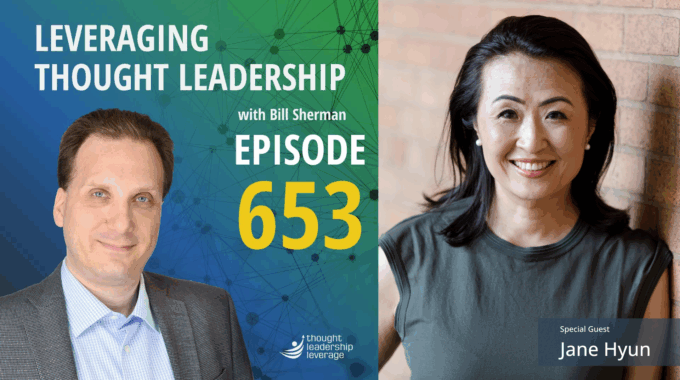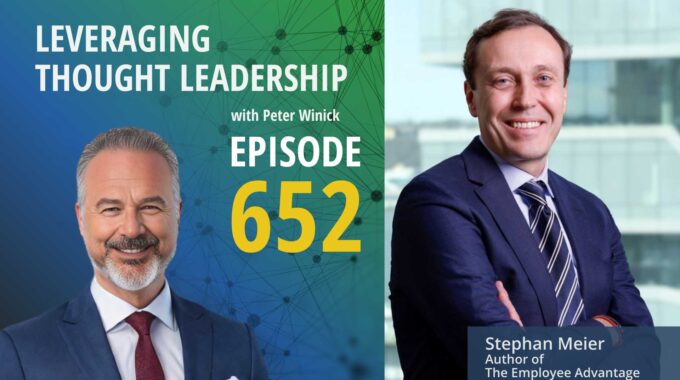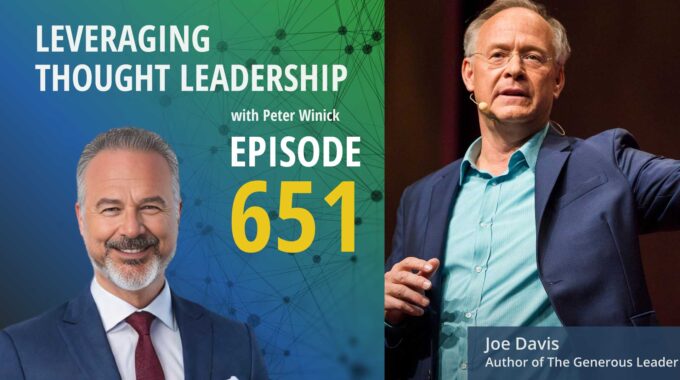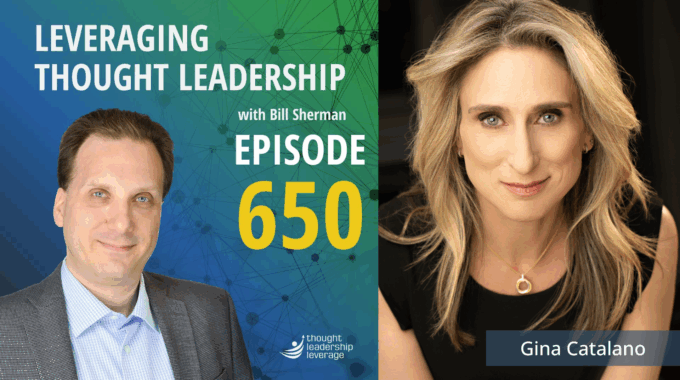The Hidden Barrier to Engagement and How to Break Through This episode unpacks how cultural…
Organizational Thought Leadership in Non-Profits | Marci Alboher
Using Organizational Thought Leadership to Elevate Lives
An interview with Marci Alboher about using organizational thought leadership in non-profits to elevate and encourage the voice of those with years of experience in business and using their longevity and wisdom to benefit the community.
We interviewed Marci Alboher, one of the nation’s leading authorities on career issues and workplace trends, and a vice president at Encore.org. Marci spent a decade practicing law, has been a blogger and columnist for The New York Times, and has now published her latest book “The Encore Career Handbook: How to Make a Living and a Difference in the Second Half of Life.” Listen in as she talks about wisdom, experience, and making a difference with organizational thought leadership.
Four Key Takeaways from the Interview:
- How organizational thought leadership can help aging and longevity be assets throughout the business world.
- Using organizational thought leadership to encourage public voices, create business fellows, and provide role models to communities.
- How to be creative and how to capture the public consciousness with your organizational thought leadership
- How to use thought leadership to navigate the change from the corporate sector to non-profit.
If you enjoyed this podcast on organizational thought leadership within non-profits, check out OrgTL.com and join the LinkedIn group and the discussion. If you need help with any aspect of your thought leadership, contact Thought Leadership Leverage. We will be glad to assist you starting with a strategy session to discover what you might need.
Transcript:
Peter Welcome, welcome, welcome. This is Peter Winick, the founder and CEO of Thought Leadership Leverage. And you’re joining us on the podcast today, which is Leveraging Thought Leadership. Today, my guest is Marci Alboher, and she is one of the nation’s leading authorities on career issues and workplace trends. And she’s a vice president at Encore. Her current focus is on the power of connecting, collaborating and innovating across the generations. Is a former blogger, columnist for Your Times and her last book was called The Encore Career Handbook. She’s been on NBC, The Today Show, Nightly News, entrepreneur, Amazing Places. And now she is with us. So welcome.
Marci Alboher Good to see you. It’s nice to be here.
Peter So you’ve got an interesting perspective because you’re on both sides of this fence, if you will. Right. So you’ve been the thought leader. You thought leader. But I want to talk a little bit about Encore and how Encore strategically uses thought leadership to achieve its objectives. Encore’s a nonprofit, you tell us first, maybe a little bit about what Encore is.
Marci Alboher So, Encore is a nonprofit. And we’ve been around for 20 years, founded by Marc Freedman, my colleague Mark, who is still the CEO of Encore. And he’s really one of the biggest thought leaders in the whole aging longevity reinventing retirement space. Marc’s written five books in this field. He’s says out on the speaking circuit and talks to the media regularly. So Mark has always, since the founding of Encore, had a vision for an organization that would work to change the culture through both changing the conversation. We call it changing the narrative and through piloting innovative programs that would change the way the world looks. So his philosophy, which, you know, I all of us at Encore believe in, is that if you’re going to change the culture, you’ve got to change the story and you kind of change society and the norms of society. So our work has always been about developing these innovative programs that I’ll tell you a little about, many of which are storytelling programs and then also identifying leaders and working with large communities of leaders, networks of leaders. So while Mark has always been a major thought leader in this space, we’ve always believed in kind of amplifying the voices of the many leaders in our movement. And our movement is around changing the story of longer lives and therefore the intergenerational opportunity of the time that we’re living in. So as you know, we’re an aging society. We now have more people over the age of 60 than under the age of 18. And I think in this moment of Covid 19, we’ve seen so much of what it means to have an older society. And our position has always been that older people are assets in society and in our communities. And we’ve done a lot to tell the story of how older people enhance society, how older people serve, how older people are necessary in society. And increasingly, our work is about how older people can collaborate and partner with and support younger people to create a better world for all of us. So that’s that mission.
Peter Yeah. Got it. So that’s the mission. So number one, given that it’s a nonprofit, we’re developing thought leadership not to sell and directly monetize or even indirectly monetize. But the successful deployment of thought leadership from Encore would lead to people engaging in programs, people becoming part of the movement, people becoming part of the community, donating whatever the case may be. So can you give us some examples of maybe a goal or two that your organization is trying to accomplish and how thought leadership is contributing to? That might not be the only variable, but it is significant.
Marci Alboher I’ll give you two examples of from our history and then something that’s very current. We’re doing so historically. We’ve wanted to reposition older people as assets in society and as change makers in society. So we started a program called The Purpose Prize, which. Large cash awards. Hundred thousand dollar prizes to social innovators over the age of 60. So instead of honoring the person who created the latest app. No sitting above their parents garage. We on honored people like a social worker who after 40 years came up with a way not to separate siblings in the foster care system or some liquidation in the social sphere. So over the course of 10 years, we honored five hundred social innovators. We gave away five million dollars and we started to tell a new story of how to be a change maker over the age of 60. And three years ago, AARP took over that prize. So one of the ways we’ve influenced the aging space is that the largest aging organization in the world adopted one of our programs to take an asset framing. And it’s part of their Disrupt Aging campaign. Now run the AARP purpose prize, which we created. So for us, success in changing the conversation means that influencers are listening. So the purpose prize always garnered all kinds of publicity and media coverage in every major media outlet you could think of. But I think the biggest sign of influence is that AARP thought it was worth adopting that program.
Peter Right. So they normally took it over. But prior to that, they had to be aware of it. Then they had to acknowledge it, recognize it and go, wow, this this is actually aligned with one of the NGOs. Right. So in the nonprofit, really the for profit world that might have been called an acquisition, like I said, you because it had value to them. So that’s pretty cool. So when you compare thought leadership, broadly defined against some of the other programmatic things that you do. How does it how does it compare? Right. So there’s.
Marci Alboher So right. Here’s a good example. So another program that is trying to change the culture, we have a program called Encore Fellowships, though, as you probably know, people are working longer and living longer. But a lot of people, you know, hit their 50s and 60s and are trying to figure out how to make a shift to an on-court career. And what one thing we found is that a lot of people were really creative, craving, meaning and purpose. Yeah, that part of life. So we created a one year fellowship for pit professionals who wanted to move from the corporate sector to the social sector. So people who want to work in a nonprofit or change organization. And we created a one year fellowship to do that. And over the past 10 years, we’ve matched more than 2000 people in those kinds of fellowships. And most of them are now working in the nonprofit sector and they have made a successful transition. And there was never a pathway to do that kind of that kind of program. So for us, that is also becomes a source of stories that we can tell to the media. So we are in touch with media reporters all the time who want stories about career changers and who want stories about people who are fighting.
Peter OK. So now you have these embedded fellows in dozens or hundreds or whatever, many companies. And when the reporter comes to you for a story, it’s not just blah, blah, blah interview. But let me tell you about Sally Smith, who is the CFO of the financial services company and is.
Marci Alboher Now. Exactly. Now, like the, you know, head of accounting for the Red Cross or for some nonprofit. So we have a story that tells this that shapes the new narrative that helps people envision what that looks like. So that’s another example. So, yeah, that essentially question.
Peter Yeah. Yeah. So my, my, what I was thinking is. There’s a you know, in traditional thought leadership when it’s an individual that’s the author, the speaker, the the whatever. Things work in a certain way. Right. You have an idea. You do stuff with that idea. You put in the book, you put vertical speed resonates, rinse and repeat. We’re going to when it’s an organization and was going back to sort of extracting the content forensically from the fellowship. It doesn’t have to be one person at the organization that is the author. So your role and I don’t put words in your mouth. And Encore is not, to be sure, the equivalent of the author of everything Encore. But it’s really the curation, the extraction, the you know, you’re the editor in chief, if you will. You’re just sort of explain the differences between the two functions because they’re different. That’s interesting.
Marci Alboher So we do both. So Mark. Mark writes and speaks correct time. And he is writing and speaking kind of helps to bring these ideas to the fore. Those two get quoted in the media to influence other innovators. I mean, we note the purpose prize, for example, there is now a purpose prize in Germany that was inspired by our purpose prize, starting a whole conversation in that country about purpose in later life. The Encore Fellowships program now exists in the UK because our work was cited and it became a model for others.
Peter So and that’s probably rather attributable to Mark as to the traditional rock star. He’s the face of the brand, if you will.
Marci Alboher Yes. Yes. And but those are not just kind of Mark’s vanity project. Here’s our programs of Kornel brand leaders and the program leaders are out there talking about those programs. Mark does his speaking and also his latest book, How to Live Forever. So that sparks all kinds of activities. But a big part of our theory is that aging, and longevity doesn’t look the same in all communities, doesn’t look like everyone. And it’s really important to us that there are many different narratives out there and many different speakers on these topics. So, for example, we launched a new fellowship two years ago called the Encore Public Voices Fellowship, which is a partnership with the op ed project. And our mission in that fellowship is to support a cadre of diverse voices talking at the intersection of longevity, aging and intergenerational issues and social justice. And we’ve supported so far 40 fellows initiative. They are diverse in every way, shape, a culturally, geographically age, diverse. We’ve had fellows from the age of 20 to 80 in that fellowship who care little issues. So now when the media knocks on the door and says, I want to interview someone to talk about issues going right now in the middle of covered, we are getting media knocking on our door all the time, saying what’s going on with intergenerational programs, Howard impacting the generations in a time where older and younger people are told to stay apart? Well, I can actually go to my public voices, fellows, and they have examples of what’s going on in their communities. And they can speak because we can’t speak to every community in the. Sure about how this is playing out.
Peter So I just think that that thinking works in profit, for profit to non-profits where it is not the job of one individual to be the only voice of the organization on everything, whether that’s a consulting firm on a high or a tech firm on something else or in the case of the inter-generational piece. But you do have to have someone in charge of sort of organizing it and being able to extract it and curating it and coaching it and all those sort of things which are very different functions because you have to set the agenda right of what’s needed. And then you have to know where to go. And it actually this this sort of crowdsourcing or democratization of the content is a bit different than the way we typically develop ideas and thoughts.
Marci Alboher Right. So we’re trying to create a movement, not sell a project product.
Peter Right.
Marci Alboher We’re trying to change the culture. And we’re also trying to make sure that underrepresented perspectives are part of the conversation. So we have learned over time that we are a gatekeeper, particularly with the media. And for, you know, conferences or looking for speakers or, you know, we know that people are coming to together for that. We’re a think tank in that respect. People are coming to us. Who is the researcher I should talk to? Who’s the community leader I should be? So it’s useful for us and for the goals that we have. And I think in a way, it’s hard to think about, you know, if a company is trying to kind of be known as a leader in a space. Often they do want one singular voice. But if they’re really trying to change behavior, for example, in some kind of way, they may find that it’s really useful to have many different kinds of spokespeople or many different kind of thought leaders out there because different thought leaders often speak to different audiences.
Peter Well. That’s a key point to what I’ve seen at the organizational level with thought. Leadership is a couple of layers of that. Number one, is it regardless of how brilliant or how smart that one person is, they’re not really even smart and everything to all people all the time. Right. That’s just not gonna happen. I think when it’s done well, most organizations have lots and lots and lots of really smart people working for them, but their voices aren’t heard because it’s not part of their job description or their functional piece. So they don’t think of themselves as a writer or maybe they’re too technical and writing such a thing eccentric. But if you put the thought, the effort in there are systems and processes and methods and stuff that you could put in place to say, oh, we can take a great story on X, Y and Z from, you know, Charlie, who’s a great a systems engineer. You know, Fred, who’s over in Africa recently, who’s over here. It’s like knowing what people have thought, leadership honor the potential to contribute in and then creating systems of doesn’t have to be financial, but recognition. Even the intrinsic people like to tell their stories and see it documented. And there’s an intrinsic satisfaction of sort of having folks do that. So.
Marci Alboher Yes. And you can also connect with different kinds of audiences and customers. If you have different people speaking about the ideas and the way that your product or service resonates. Right. So you can hit people of different ages. You can get people through social media channels because.
Peter You know, when you’re in your case on the intergenerational piece, it it’s sort of a one hit wonder if we’re only hearing about the perspective of a 65 year old white man. This is where various voices on that beat it beat a 26 year old or a forty year old or, you know, where they’re geographically located, racial issues. You know, all that stuff. And it shouldn’t be a one a one trick thing so far.
Marci Alboher I think one thing that’s so interesting is the way that the way the way the conversation around ageism has shifted. Now that there are younger people talking about what it feels like, that there are an absence of older people in their field. So, for example, when you have a young person in their 20s saying, I can’t find a mentor because they’ve all been aged out of my workplace, that’s a very effective way to have a conversation about ageism rather than just having a bunch of sixty five year olds say, right now, I’ve been a product of age discrimination. So I think it’s pretty important to get different perspectives if you’re really trying to change the culture and change behavior.
Peter Yeah. Yeah. So let me ask you this, then. How do you know any program that you have, even though it’s a nonprofit, you have to justify its existence based on its impact, its return on investment, that it’s achieving its objectives. What are the metrics that you put in place and can you give an example or two of this thing? Just get it out of the park?
Marci Alboher Yes, I can. So here’s an example of how we look at metrics. It’s we looked at we trace things that happened. So, for example, Mark, our founder, wrote a note to our email list. I’m sure all CEOs do that. You know, in the current pandemic environment. And he wrote about what what it meant for us and our movement. And he was contacted by a Wall Street Journal reporter who wanted to talk about the separation between older and younger in this period, because Mark had wrote about it, written about it very eloquently in our newsletter. He was in his story about how he and his kids were connecting with his mother over video was fired up on the front page of The Wall Street Journal.
Peter Very cool.
Marci Alboher That’s an example. I’m sure, you know, in any in any setting that is considered a homerun. One of our public voices fellows, Alex Smith in the U.K. has a really compelling organization in London that’s attacking the loneliness epidemic. And that’s 30000 people in the U.K. that are older and younger neighbors that are connecting together over like intergenerational dance parties and all kinds of older and younger. But right now, when older and younger can’t be together, he’s trying to innovate their community, trying to fit. Figure out what are the new ways that people can connect. So he wrote an article about that in The Huffington Post. Yes, Barack Obama tweeted it. So that was just a home run. So same thing.
Peter So, the bar is pretty high, so. A Barack re-Tweet, Huffington, the Journal?
Marci Alboher These are considered successful. So, you know, I could say about eyeballs, we care about eyeballs because we’re trying to influence the public dialog so that policymakers pay attention, so that funders pay attention and think about funding the kinds of programs that are and the kinds of the kinds of efforts that are going on in the structures of the world that we live in. So we don’t want everybody to have to just figure out their own graphics for how to be less. Isolated. We want more structural changes that will help us be less isolated in the first place.
Peter Got it. So as we start to wrap. Thinking out in the next year, three fives. Do you think they’ll be increases in investments that organizations make in thought leadership? Will it stay the same? Will it go down?
Marci Alboher It’s funny, I think. I think you. You’re one of the people who told me that you searched the words thought leadership on LinkedIn and suddenly it was showing up in people’s job titles. And I think that was a.
Peter Thirty three hundred as of yesterday.
Marci Alboher So I think there is something there. I get myself a new title this year. I called myself a head of narrative change efforts. I think we’re seeing more of these kind of interesting titles that have to do with the power of storytelling to change the conversation. Yes, change these behavior. So I do think that thought leadership is becoming increasingly important in all spheres. Yeah. How we shift the public dialog. And it is, of course, then gets harder and harder to break through the noise. Right. And to think about how to be creative and how to capture the public consciousness. So I think that’s where people are being. There’s always going to be you have to be a few steps ahead of the game.
Peter Sure. In any sense as to if it’s growing usually. And particularly the nonprofits. But it all organizations, the pie doesn’t necessarily grow equally. It usually at the expense of. So what do you think? What type of initiatives might be at risk as thought leadership grows as a as a capability, as a function, as a way to achieve the business objectives?
Marci Alboher That’s a really interesting question. I don’t look at things as having a zero sum. I think you can. I think if you’re doing thought leadership well, it can really help advance all your other goals. If you’re trying to change behavior in any way and if you’re trying to change the culture. It really, really helps to change the story and to use stories that here’s a perfect example of what I think we’re seeing right now and I keep talking about to the current moment because it’s all on our minds. I think Governor Cuomo in New York is doing an incredible job of connecting by humanizing this story in every single press conference. He’s got a story of his own family in ways that we can all relate to. It is so personal.
Peter Yeah, he’s mentioning his kids and.
Marci Alboher His mother. His brothers. Yes. All coming to life in such a reason.
Peter Yeah.
Marci Alboher He’s taken a moment to show that he’s not just a leader, but he is using thought leadership and getting us. He’s taken over that press conference, which is now broadcast nationally, not just in New York.
Peter Yeah, exactly. And let’s add on again that this has been great. I appreciate your time and your insights. It has been fantastic. And thank you so much.
Marci Alboher My pleasure, Peter.
